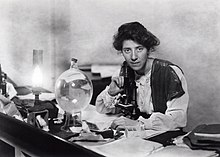
Eugenic feminism was a current of the women's suffrage movement which overlapped with eugenics.[1] Originally coined by the Lebanese-British physician and vocal eugenicist Caleb Saleeby,[2][3][4] the term has since been applied to summarize views held by prominent feminists of Great Britain and the United States. Some early suffragettes in Canada, especially a group known as The Famous Five, also pushed for various eugenic policies.
Eugenic feminists argued that if women were provided with more rights and equality, the deteriorating characteristics of a given race could be averted.
- ^ Rosario, Esther (2013-09-13). "Feminism". The Eugenics Archives. Archived from the original on 2019-09-09. Retrieved 27 October 2018.
- ^ Saleeby, Caleb Williams (1911). "First Principles". Woman and Womanhood A Search for Principles. New York: J. J. Little & Ives Co. MITCHELL KENNERLEY. p. 7.
The mark of the following pages is that they assume the principle of what we may call Eugenic Feminism
- ^ Cite error: The named reference
wsuffragewas invoked but never defined (see the help page). - ^ Gibbons, Sheila Rae. "Women's suffrage". The Eugenics Archives. Retrieved 31 October 2018.
Dr. Caleb Saleeby, an obstetrician and active member of the British Eugenics Education Society, opposed his contemporaries – such as Sir Francis Galton – who took strong anti-feminist stances in their eugenic philosophies. Perceiving the feminist movement as potentially "ruinous to the race" if it continued to ignore the eugenics movement, he coined the term "eugenic feminism" in his 1911 text Woman and Womanhood: A Search for Principles